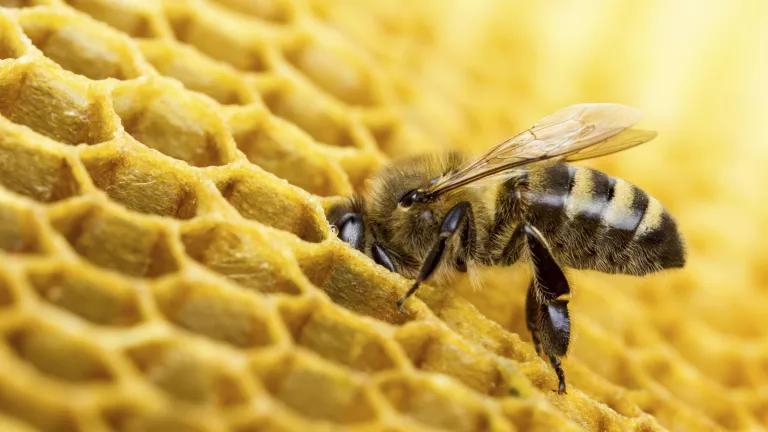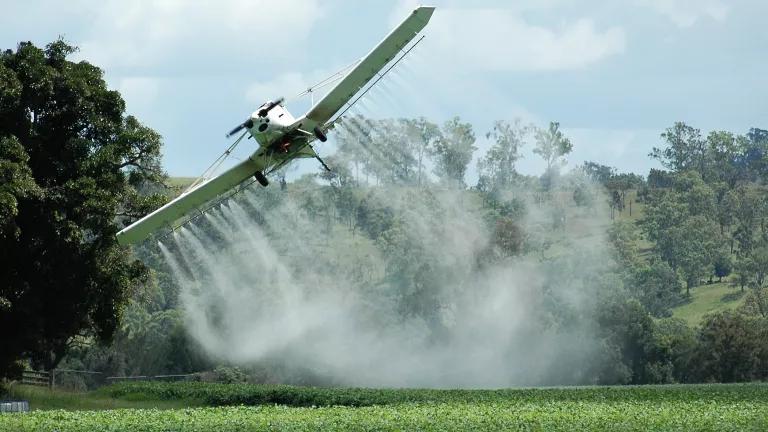
A honeybee
Today is World Bee Day—a time to celebrate our buzzy friends as well as recognize the grim challenges that they face. And while recent headlines question the need to “save the bees,” highlighting honeybee population rebounds, they miss the bigger picture: namely, that bees are still in crisis, and honeybees keep telling us so.
To be fair, these articles emphasize an important and often unknown fact: honeybees are not native to the U.S. and are essentially livestock. Bred by beekeepers and literally trucked across the country to pollinate everything from almonds in California to blueberries in Michigan, honeybees enjoy the special status of domesticated species—i.e., that many people are actively employed keeping them around.
But that doesn’t mean they’re doing so hot.

There are still plenty of bee colonies, but scratch below the surface, and you can see a system in crisis.
In the mid-2000s, honeybee colony losses skyrocketed almost overnight—jumping from 10-15% per year, mostly due to winter cold, to around 30-50% per year and happening year-round. Since then, these extreme losses have continued unabated and, if anything, have gotten worse. But now we have more honeybee colonies than we did 20 years ago, so what gives? Put simply, beekeepers are breeding a lot more bee colonies to offset the massive year-over-year colony die-offs.
This raises two key points that the headlines miss. First, beekeepers continue to struggle to maintain honeybee populations, and with colonies weaker than ever, our food system could be one new disease or parasite away from a sudden-onset catastrophe. Even now, increased pollination costs contribute to increased food costs, and research shows production of many key crops is already limited by a lack of bees and other pollinators.
And that limitation isn’t just because of weak and dying honeybees. Our wild bees—over 4,000 species of which are native to the U.S.—and other pollinators continue to disappear at disturbing rates. These losses form part of a larger recent trend of across-the-board insect losses (sometimes dubbed an “insect apocalypse”), but pollinators are especially hard hit—e.g., monarch butterfly populations shrunk up to 72% over the last decade and several native bumblebee species declined up to 96% over the last two. Many of these species are even better crop pollinators than honeybees, and with 80% of plants dependent on pollinators to reproduce, all are critical keystone species for our ecosystems.

What's killing the honeybees is also killing our many diverse wild bees, like this gorgeous green-metallic sweat bee.
Honeybees and wild bees share the same recent and alarming loss trend, but while we rarely count wild pollinator populations, we do count honeybees. That means that—and this is key point two—far from being a distraction from a larger biodiversity problem, honeybees are our canaries in the coal mine, ringing yearly alarms about precisely that problem.
What’s causing this crisis? The answer includes multiple factors such as climate change, habitat destruction, and disease. But while all of those stressors have been steadily building for a long time, only one stressor maps with the sudden spike in bee losses, and that’s the sudden spike in use of a relatively new pesticide class known as the neonicotinoids or “neonics.”
Neonics are now the world’s most widely used insecticides and possibly the most ecologically destructive since DDT. Among the most potent insecticides ever created, just one square foot of neonic-treated lawn can have enough active ingredient to kill a million bees, and their widespread use as coatings on crop seeds has made U.S. agriculture 48-times more harmful to insect life.
Neonics’ harmfulness also comes from the novel way in which they work. Designed to permeate plants—making every part of the plant toxic inside and out, from root to flower—neonics also permeate ecosystems: persisting in soils; migrating easily in rainwater; and building up in our soil, water, and wildlife from year-over-year nationwide use.
While chemical companies have long fought an information war to make neonics look “safe,” scientific studies have been piling up for over a decade linking neonics not only to honeybee colony losses, but also the disappearance of wild bees and butterflies, mass losses of birds, the collapse of fisheries, and birth defects in deer. People aren’t immune either. A recent study found neonics in the bodies of over 95% of pregnant women nationwide, with detected levels increasing every year—raising alarms from health experts given neonics’ links to birth defects and a whole host of neurological and hormonal harms.
The latest trend of throwing shade on honeybees (and those keeping them) does get one thing right: we can’t breed our way out of the biodiversity crisis or avoid that crisis by focusing only on honeybees. But if we listen to the warning our fuzzy little friends are sending, we can tackle the underlying and preventable problems that threaten all bees, our ecosystems, and ourselves.
And that’s exactly what NRDC is doing across the country—helping to pass policies in New York, New Jersey, Minnesota, Nevada, and California to eliminate the unnecessary and destructive uses that account for the vast majority of neonic use. If you really want to “save the bees” this World Bee Day, reach out to your elected officials—whether it’s they’re in the state house or Congress—and let them know you want them to rein in reckless neonic pollution too.




